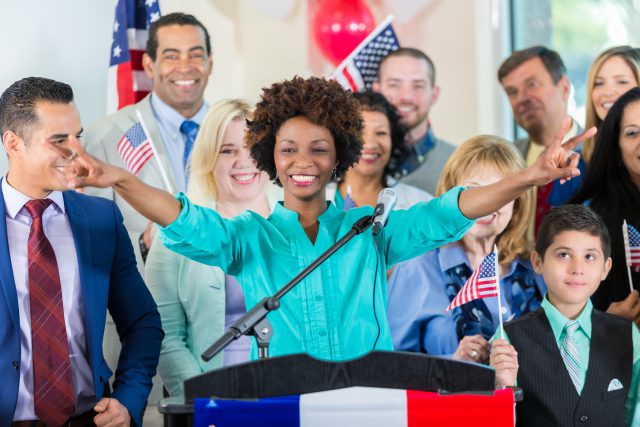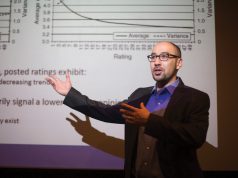
Political advertising is a huge phenomenon in the United States. In 2020, Forbes reported that an eye-watering $8.5 billion was spent in the last election cycle, with hundreds of millions earmarked for airtime buys on TV, radio and digital media for runoff races.
Some of these ads are paid for by political candidates themselves using funds from donor organizations or individuals. Others are funded by so-called Political Action Committees or PACS – clusters of interested parties who have no formal tie or link to the candidate or party they endorse.
PACS have been a recent focus of interest – and not inconsiderable controversy – not least because of a lift on the limits they are permitted to spend and a certain opacity around the source of their funding. Unlike candidates, these groups face no legal requirements to cap campaign financing or reveal the identity of donors – the result of a landmark 2010 case in which SuperPAC Citizens United successfully argued that private campaign funding was a function of “free speech.”
But with the tally of U.S. dollars spent on electoral campaigns on the rise, more questions are being asked.
First off there’s the question of whether advertising actually works or not. Are these dollars mobilizing votes and if so, what’s the net impact?
There is also growing concern about the nature of political advertising itself. As the U.S. slides into deeper polarization, more and more candidates and PACS are going on the offensive – laying into the opposition with content that is essentially negative and deprecatory. With the focus swinging from “take a look at my manifesto” to “take a look at how badly the other guy will pan out,” there’s the worry that warring factions will only serve to disunite the United States further.
The Resulting Impact of Political Advertising Spend

Casting important light on this is new research by Goizueta Professor of Marketing David Schweidel. He has leveraged a marketing curiosity in the US to measure the influence of political advertising across different states – particularly in those swing states, where the battle for political influence is being fought most vociferously. And he has found something significant: when the ads come from the candidates themselves, there is a discernible uptick in support among voters. The same, however, is not true for the PACS.
“In our study we’ve found that PAC-sponsored advertising is not swaying voters one way or the other, particularly in those battle-ground states like Georgia or Wisconsin where the spend is really high,” says Schweidel.
When the ads come from the candidates themselves, on the other hand, there is a concrete impact: when candidates increases their advertising spend by 1%, there’s a concomitant 0.015% increase in turnout for that candidate. And while that might not sound like much, says Schweidel, it is significant.
To get to these findings, Schweidel worked with colleagues from Goizueta and the University of British Colombia, exploiting a curious historic anomaly that divides the United States into a set of targeted geographies for marketers.
Known as designated marketing areas (DMAs) these media markets are based on metropolitan areas and their suburbs. Residents living in a DMA will receive the same TV and radio stations. And what makes them interesting in the context of the study, is that in some cases they do not follow state borders.
Crossing State Lines with Influential Marketing
“DMAs are defined for marketing convenience. They are basically broadcast or media markets where advertisers can reach households of people living there,” says Schweidel. “In some instances, DMAs cross state lines. In Florida or Alabama, for instance, people might get advertisements on their TV, radio, or other channels that was actually meant for consumers in Georgia.”
To gauge the impact of political advertising on voters, Schweidel and his colleagues collected data from Kantar Media’s Campaign Media Advertising Group (CMAG) and matched it to voting outcomes in 2010 and 2012 senate elections in counties where DMAs straddle state lines.
“In certain states, you know enough about the voting history to be able to predict with confidence how its residents will vote during elections,” says Schweidel. “So, with these border areas, where residents are going to receive accidental targeting meant for another state, we looked for differences or anomalies in the voting patterns that indicate impact coming from advertising.”
In total, Schweidel and his colleagues analyzed data from nearly 3,000 counties across the country. And while their findings may resonate well with candidates, the news is far less favorable for PACS.
“Basically we don’t see any effect coming from PAC-sponsored advertising in these areas,” says Schweidel. “It’s likely that this is to down to a lack of credibility,” he adds.
“When people see these third-party ads, they don’t know who they are or where they come from,” Schweidel says “There’s nothing in the fine print that indicates the source or the agenda behind it and voters seem to register this – and the fact that whoever these advertisers are, they won’t be accountable after the advertisement airs.”
PACS vs. Candidate Advertising: Which Garners More Votes?
When a candidate appears on people’s screens or airwaves, however, there is an assumption that he or she will be obliged to stand by whatever message is shared and deliver on promises made – an assumption that translates into a change in voting behavior, the researchers find.
For every 1% increase in advertising spend made by candidates, they get an uptick of 0.015% in votes in these areas. And though the effect might appear small, Schweidel cautions that the potential impact is highly significant – particularly for battleground states.
“Take Georgia. If you have a candidate putting just 1% more into their advertising spend and you see a shift of 0.015% in voting on the basis of that advertising, you’re looking at an additional 1500 votes for that candidate.”
Multiply the extra spend by 10, and those extra votes become 15,000.
“In the recent presidential election, the difference between candidates was just shy of 13,000. On the basis of our research, had either increased their advertising efforts in Georgia, it could have been enough to swing the entire election.”
As to the nature of the advertising itself, Schweidel is under no illusions.
“In the last few years, the tone has really shifted in the U.S. Today around 80% of the messages and propaganda we’re seeing is essentially all about attacking the opposition. Why do they do it? It’s almost a moot point. Negativity works.”
Negative political advertising is more effective, says Schweidel, because it taps into extreme emotions such as anger or fear; and these are the emotions that mobilize human behavior.
On that basis, and the understanding that political advertising works, he is confident that more of this kind of activity will go forward – especially in battleground states which have strategic value in deciding outcomes.
“Biden won in the battleground states – Georgia, Pennsylvania, and Wisconsin – and these are states that were a very close call. So, we will see more of these kind of ads in these states because they can tip the balance of power.” As to whether this is a good or bad thing remains to be seen, says Schweidel.
He adds, “Galvanizing people to show up to vote has its merits for sure. The biggest issue is that these ads are getting more and more extreme, and that’s a worry because it only contributes to the political polarization and divisiveness in the country.”










